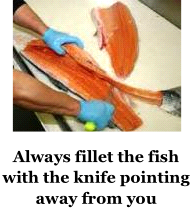
RECIPES
INTRODUCTION
RECIPES INDEX
BACK TO TABLE OF CONTENTS
Now you've caught me ... What are you going to do with me?
So, you finally caught your fish - Well Done!
The great thing about game fish as opposed to coarse fish is that you can eat what you catch. Some say that this is what makes game fishing justifiable. Their view is that catching a fish simply to put it back in the water induces great stress in the fish, many of which do not survive the experience. Salmon and trout fishing, on the other hand, not only appeals to the hunting instinct but fulfils the instinct to provide food at the most basic level. Whatever the philosophies are behind all this, I just like to go fly fishing, catch my fish and take it home. And it tastes great, once you've worked out what to do with it. This section deals with how to clean and prepare your fish followed by a wealth of ideas of how to cook and present it.
KEEP IT CLEAN!
Once you knock it on the head and despatch it to the great lake in the sky, the flesh starts to age (which is a nice way to say it will start to rot) – and in warm weather that will happen remarkably quickly. You should always keep your fish in a hessian or mesh bag in the water while you carry on fishing, otherwise it will curl up, dry out and be unfit for eating - not to mention attracting a host of flies!.
You should try and clean the fish as soon as possible or else the fish's waste will contaminate the flesh. But please only do this at the fishery if they are kind enough to provide a cleaning station and somewhere to dispose of the nasty bits. And never, ever clean your fish and dump the guts in the water - that will contaminate the water and get you banned if you get caught. In the wildest parts of the world cleaning your fish can attract unwanted visitors such as bears, so be careful about what you do and where you do it. If you intend to freeze your fish you must clean it first.
I wish I had a penny for every fish I've cleaned and I worked out there is an easy way to do it. Here's how: slide a sharp pointed knife into the fish's vent - a nice word for its anus - it only needs to go in a centimetre or so. Point the knife at the fish's chin and slide the knife straight up the belly with a gentle sawing motion to just past the gills. This will open the stomach cavity, with its contents intact. Slip your hand into the cut and up into the chin. You will feel a tube - the fish's throat. Grab hold of this tube, slide the knife in, cut the tube as far forward as you can get and pull the loose end out of the cavity. All the guts should come out with it in one go. You may need to pull quite hard to tear the vent free of the surrounding flesh - you may have to cut around the vent to free it on larger fish. Those larger fish will also have a clear membrane that surrounds the internal cavity and this also should be pulled free.
Open the cavity and give it a rinse under running water to clean out any blood. You will now see a whitish membrane running down the inside of the backbone. Run you knife down this to cut it open and remove the black strip inside, either with the back of your thumbnail or a spoon. My filleting knife has a spoon built onto the end of the handle for this purpose. Remove the head and tail if necessary. If you intend to cook the fish with the head still attached then you will need to remove the gills. This is easily done with a pair of kitchen scissors or shears. Each gill branches out from a single root. Find that root and snip it at the top and bottom and the gills will come out in one go. Use the scissors to snip off the fins still attached to the body and that's it - job done.
 If your recipe calls for fillets then you will need to remove the usable sections of flesh from the rest of the body. Perform all the operations above and then, with a thin filleting knife, make a cut down the full length of the back of the fish, cutting either side of the dorsal fin. Now gently slice the meat off the ribs in two pieces, starting at the shoulder and working down and across the fish. This is just a matter of holding the knife against the ribs and using them as a guide as you slice through the flesh. Then turn the fish over and repeat for the other side.
If your recipe calls for fillets then you will need to remove the usable sections of flesh from the rest of the body. Perform all the operations above and then, with a thin filleting knife, make a cut down the full length of the back of the fish, cutting either side of the dorsal fin. Now gently slice the meat off the ribs in two pieces, starting at the shoulder and working down and across the fish. This is just a matter of holding the knife against the ribs and using them as a guide as you slice through the flesh. Then turn the fish over and repeat for the other side.
Once the fillet is removed, you will find a set of pin bones running along the centre line and these can be removed with a pair of tweezers or small pliers. Alternatively, you can remove these pin bones the easy way. Lay the fish flat, skin side down and just make two cuts down to the skin - but not through it - either side of the line of pin bones to make a V shape meeting at the skin. You should then be able to lift out this thin strip of flesh - pin bones and all!
If you need just the meat then you will need to remove the skin as well. Place the fillet, skin side down, on a chopping board and grasp the tail end firmly between finger and thumb - some people find the skin too slippery to grasp and use a pair of pliers to hold it. Cut down through the meat right next to your thumb to the underside of the skin and hold it flat, skin side down on the chopping board. Holding the blade of the knife nearly horizontal saw the knife back and forth as you pull the fish gently towards you. The flesh is a lot softer than the skin so the knife will take the path of least resistance between the meat and the skin. And that's it ... cleaned, filleted and skinned. If you intend to freeze your fish then each piece should be put in its own bag and sealed with as little air in the bag as possible. Do not keep your fish beyond the freezer manufacturer's recommendations for fresh frozen fish.
Now let's look at what we can create with our catch.
SMOKING YOUR FISH
 Smoked fish tastes great and the act of smoking it also preserves the fish at the same time. We all know about smoked salmon and some of the store bought stuff can be pretty grim. We're back to the old "you get what you pay for" routine. So why not solve the problem by smoking it yourself? It's not as hard as you think and you can do a whole batch and freeze it for later.
Smoked fish tastes great and the act of smoking it also preserves the fish at the same time. We all know about smoked salmon and some of the store bought stuff can be pretty grim. We're back to the old "you get what you pay for" routine. So why not solve the problem by smoking it yourself? It's not as hard as you think and you can do a whole batch and freeze it for later.
There are two ways to smoke a fish - this sounds like the start to a Harpo Marx joke (either way it’s hard to light...yadda yadda)! Cold smoking requires a smokery and the fish, once infused with the smoke is left to hang for several days. This method is best left to the professional smokery. The other and more user friendly way is hot smoking. The fish is effectively cooked in hot smoke and preserved at the same time. There are many fish smokers on the market and you can find a wide variety for sale over the internet and they all work in much the same way.
Hot smoking must be done outdoors and in an area that is not likely to cause offence, because, unsurprisingly, quite a lot of smoke is created during the operation. You should ensure that the smoker is placed on a fireproof surface as it will get extremely hot. The first time I tried it I put my smoker on a tarmac drive and promptly melted the tarmac! The smoke is generated by burning wood chips or sawdust in the bottom of a fireproof container and the fish are laid on a grill above the smoke. The wood chips or sawdust can be ignited either from inside or, more normally, by placing a small tray of methylated spirits in a recess beneath the container. The heat passes through the container and burns the wood chips by indirect contact.
When smoking fish it is important to salt the fish first or the smoke will not penetrate the flesh. Salting has two purposes. Firstly it will draw some of the water out of the fish, making the flesh firmer. Secondly it will neutralise any muddy taste of which some reservoir caught fish may be slightly guilty. Put a thin layer of sea salt in the bottom of a shallow dish and lay the fish flat in the dish and sprinkle generously with the sea salt, lightly rubbing it in. Leave for an hour or so to allow the salt to slightly flavour the fish. Even sea run fish such as salmon should be salted before smoking to ensure the smoke takes to the flesh. Brush the salt off before smoking - don't rinse it off or the fish will be too wet to smoke.
Once the wood chips are smoking a lid is placed over the container. This creates a build up of smoke and heat inside the container, forcing the smoke into the flesh. Because of the high heat generated, the process only takes 20 minutes or so and the fish is then removed. More fish can be added to continue the process if required. This hot smoking technique is suitable for whole cleaned fish as well as skinned or skinless fillets. Obviously, very large fish will need to be cut into pieces or the smoke will not be able to permeate the flesh. Always read the instructions on your own particular smoker. Once smoked, your fish can be wrapped in kitchen film and frozen for use at a later date - up to 30 days.
***